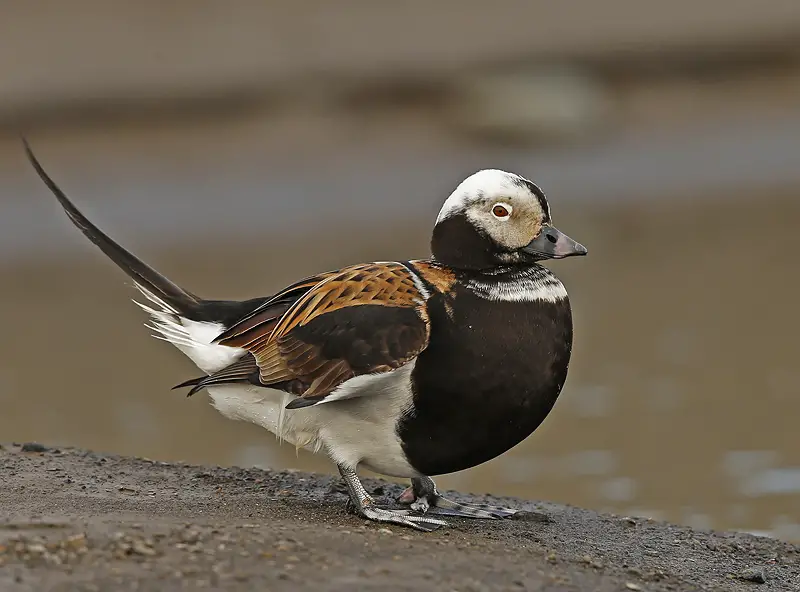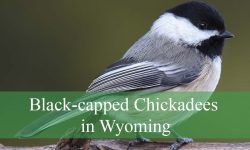In Michigan’s cold season, long-tailed ducks stand out as vibrant, fast-moving visitors scattered across deep lakes, protected bays, and open coastlines. Their crisp plumage, rapid diving behavior, and constant vocalizations make them unforgettable to anyone who encounters them along the Great Lakes shoreline. Although they may appear briefly each winter, their lives reveal extraordinary adaptations shaped by the harsh conditions of the Arctic.
Michigan’s coastal environments provide an essential winter refuge for these ducks as they escape frozen northern seas. Their presence is particularly notable along Lake Michigan and Lake Huron, where cold open waters remain accessible throughout winter. These birds transform Michigan’s winter waters into a stage of nonstop activity.
This article uncovers hidden facts about long tailed ducks in Michigan, exploring their unusual diving abilities, distinctive vocal behavior, migration patterns, feeding ecology, and seasonal rhythms that most observers never fully realize.
Understanding Long-Tailed Ducks in Michigan

What Long-Tailed Ducks Really Are
Long tailed ducks are medium sized sea ducks known for their bold patterns and remarkably long tail feathers in males. Their plumage changes dramatically between winter and summer, reflecting their adaptation to life between Arctic breeding grounds and temperate wintering waters. Their compact bodies and strong wings allow them to fly great distances while maintaining maneuverability in high winds.
Unlike many waterfowl, long tailed ducks possess one of the most distinctive vocal repertoires among sea ducks. Their yodel like calls echo above Michigan’s waves in winter, creating an unmistakable soundscape. These calls help maintain flock cohesion, especially during offshore feeding bouts.
Why Michigan Provides Suitable Habitat
Michigan’s Great Lakes offer deep, cold, nutrient rich waters that remain partially unfrozen throughout winter. These conditions support abundant aquatic invertebrates—an essential winter food source for long tailed ducks. Large bays, open coastlines, and offshore reefs along Lake Michigan and Lake Huron create reliable foraging zones.
Michigan’s position along major migratory pathways also makes it an important stopover region. Ducks can rest, feed, and regain energy here before traveling farther east or west. The state’s combination of open water and sheltered bays gives long tailed ducks multiple habitat choices during winter storms.
Where They Occur Across the State
Long tailed ducks appear primarily in coastal regions, particularly near Ludington, the Straits of Mackinac, Grand Haven, Alpena, and the eastern Upper Peninsula. Offshore waters and deeper lake basins host the largest winter groups. Occasionally, individuals wander into inland lakes, especially after severe storms push them off primary migration routes.
Hidden Behaviors Few People Notice
They Are Exceptional Deep Divers
Long tailed ducks are among the deepest diving ducks in North America. They regularly reach depths over 150 feet, far beyond what most diving ducks can achieve. Their diving ability is supported by strong chest muscles, compact bodies, and wings adapted to underwater propulsion. In Michigan, they often dive repeatedly over offshore reefs, searching for mollusks, crustaceans, and insect larvae.
Their Plumage Changes Dramatically
Most ducks undergo seasonal changes, but long tailed ducks display some of the most complex plumage variations of any waterfowl species. Their appearance shifts between bold white patches in winter and darker, earth toned plumage during summer. These changes provide camouflage against snow and ice in the Arctic while offering protection in Michigan’s darker winter waters.
Constant Vocalizing Sets Them Apart
Long tailed ducks are highly vocal throughout winter, especially during feeding and social interactions. Their rhythmic calls help maintain group structure when visibility is reduced by fog, waves, or snow. Michigan’s windy shorelines amplify these calls, creating unique winter soundscapes around harbors and rocky points.
Anatomy Built for Life in Michigan Waters
Insulated Plumage for Extreme Cold
Their feathers trap thick layers of air, providing exceptional insulation during freezing winds and snowy conditions. They rely on dense underfeathers that repel water and retain warmth, even after repeated dives into icy Great Lakes waters.
Specialized Legs and Feet
Their legs are positioned far back on the body, helping propel them underwater with strong, controlled strokes. This placement reduces efficiency on land but enhances their diving ability—crucial for winter feeding in Michigan’s deep waters.
Eyes Adapted for Low Light
Long tailed ducks have excellent underwater vision. Their eyes adjust quickly between air and water environments, allowing them to detect prey in dim, cloudy water typical of winter lakes.
Feeding Habits Across Michigan
Diving for Aquatic Invertebrates
Long tailed ducks feed primarily on benthic invertebrates such as amphipods, mollusks, small clams, crustaceans, and insect larvae. They dive repeatedly, sometimes dozens of times in a row, retrieving prey from lake bottoms or midwater depths.
Diet Shifts With Water Conditions
In calm conditions, ducks dive deeper and hunt for mollusks. During storms, when deeper waters become turbulent, they switch to shallower prey such as small fish and surface drifting insects. Their flexible diet helps them survive Michigan’s unpredictable winter conditions.
Coastal Feeding Strategies
Along Michigan’s piers, breakwalls, and rocky edges, ducks forage among underwater crevices where prey becomes trapped. These areas remain productive even during icy spells, making them winter hotspots for long tailed ducks.
Migration Patterns—A Complex Journey
Long Distance Migrants
These ducks travel thousands of miles each year between Arctic breeding grounds and wintering waters across North America. Michigan lies along several major migration corridors, serving as both a stopover and wintering destination.
Timing Their Movements
Most arrive in Michigan between late October and December. Their departure begins in March, with some lingering until early May depending on ice conditions. Their migration timing closely follows shifts in temperature and prey availability.
Flock Dynamics
Long tailed ducks migrate in coordinated groups, relying on visual and vocal signals to maintain formation. Their tight flocks help reduce predation risk and increase aerodynamic efficiency during long flights.
Long-Tailed Ducks Across Michigan Landscapes
Great Lakes Coastlines
Lake Michigan and Lake Huron support the largest winter concentrations of long-tailed ducks. The expansive shorelines and cold, open water give them consistent access to deep foraging zones even during harsh weather.
Waves churning against rocky points and river mouths constantly stir up benthic invertebrates, creating rich feeding hotspots. Long-tailed ducks gather just beyond the breakers, diving repeatedly as stirred sediments release crustaceans and mollusks.
On stormy days, their presence becomes even more visible. Flocks ride the rolling waves, surfacing in synchronized patterns that highlight their remarkable adaptation to the turbulent conditions of the Great Lakes.
Bays and Harbors
Sheltered bays like Grand Traverse Bay and Thunder Bay offer calmer water where ducks can dive more efficiently without fighting heavy winds. These quieter basins act as winter refuges during periods of extreme cold or strong gales.
Mixed flocks commonly form here. Long-tailed ducks, scoters, and goldeneyes share the same feeding grounds, each species targeting a different depth or prey type. This natural partitioning allows them to coexist with minimal competition.
Because bays tend to hold steady temperatures and avoid full ice coverage, they remain valuable resting and feeding zones throughout the season.
Offshore Reefs
Submerged reefs and rocky ridgelines function as underwater feeding platforms. These sites concentrate mollusks, amphipods, and crustaceans—prey that long-tailed ducks specialize in accessing with their deep-diving ability.
Many of Michigan’s reefs lie well offshore, where cold currents and wave action bring a continuous supply of nutrient-rich water. Ducks may disappear underwater for long intervals, resurfacing only to swallow prey before diving again.
These offshore structures become especially important during the coldest months, when food in nearshore waters becomes scarce or shifts with changing ice patterns.
Occasional Inland Sightings
Although they are primarily offshore birds, long-tailed ducks occasionally appear on inland lakes after powerful storms. Strong winds can push migrating flocks far away from their intended routes, forcing them to rest on quieter inland waters.
These visits are usually brief. Once weather stabilizes and winds shift, ducks typically return to the Great Lakes, where food resources are far more abundant.
Seasonal Rhythms in Michigan
Winter Residency
Winter is the peak season for long-tailed ducks in Michigan. Their activity often intensifies during cold, windy days when wave action dislodges prey from the lake bottom.
They dive in rapid cycles, flying low across the water between feeding spots. Their movement patterns create a distinctive winter spectacle along Michigan’s shores.
Late Winter Pre-Migration Feeding
By late February and March, ducks shift into intensive feeding mode. They increase the frequency and duration of their dives to build crucial fat reserves.
This pre-migration period often brings birds closer to shore, allowing easier observation as flocks cluster near piers, breakwalls, and harbor mouths.
Spring Departure
Warming winds, expanding open water, and increasing daylight signal their northbound journey. Ducks gather into tight, coordinated groups before lifting off toward the Arctic.
Their departure marks one of the final transitions from winter to spring along Great Lakes coastlines.
Interaction With Other Wildlife
Birds
Long-tailed ducks regularly share winter waters with scoters, mergansers, goldeneyes, and loons. Each species feeds at different depths or targets slightly different prey types, reducing direct competition.
Mixed flocks are especially common near piers and river mouths, where food is concentrated. The presence of multiple species also increases collective vigilance against predators such as bald eagles.
Mammals
Though interactions are limited, river otters and mink occasionally hunt near shallow areas where ducks rest. In such cases, long-tailed ducks shift farther offshore to avoid potential danger.
Harbor seals are rare in the Great Lakes but can appear near shipping routes. Even so, encounters with ducks remain minimal and generally do not influence behavior.
Fish and Invertebrates
Long-tailed ducks play a significant ecological role by consuming benthic invertebrates. Their deep dives help regulate populations of mollusks and crustaceans, preventing certain species from dominating the lake bottom.
This feeding behavior influences nutrient cycling and helps maintain the delicate balance of Great Lakes food webs.
Myths and Misconceptions
Myth: Long-Tailed Ducks Only Live in the Arctic
While they breed in Arctic regions, long-tailed ducks depend heavily on wintering habitats like Michigan’s Great Lakes. These waters are essential to their survival.
Myth: They Are Rare in the Great Lakes
They are actually quite common each winter. Their offshore habits simply make them harder for casual observers to spot.
Myth: They Are Poor Fliers
Despite spending most of their time on the water, long-tailed ducks are strong migrators capable of fast, sustained flights and quick takeoffs from rough waves.
Ecological Importance
Regulating Benthic Communities
By feeding on mollusks, amphipods, and crustaceans, long-tailed ducks help prevent overpopulation of benthic invertebrates. This maintains ecological stability on the lake floor.
Supporting Predator Food Chains
During migration, long-tailed ducks serve as prey for bald eagles, peregrine falcons, and other raptors. Their presence sustains predator populations at critical seasonal intervals.
Indicators of Great Lakes Health
Stable winter numbers can signal healthy benthic ecosystems and adequate food availability. Sharp declines, in contrast, may indicate pollution or habitat changes within the lakes.
FAQs About Long-Tailed Ducks in Michigan
When are long tailed ducks most common in Michigan?
From late fall through early spring, especially along Lake Michigan and Lake Huron.
What do they eat?
Primarily aquatic invertebrates such as mollusks, crustaceans, and larvae.
Why do they dive so deep?
Deep diving allows them to access prey other ducks cannot reach, giving them a unique feeding niche.
Do they breed in Michigan?
No. They migrate to Arctic regions for breeding each summer.
Where can I see them?
Harbors, offshore points, rivers meeting the Great Lakes, and deep coastal waters.
Conclusion
Long tailed ducks in Michigan represent one of the most remarkable winter spectacles on the Great Lakes. Their diving talent, vocal behaviors, and migration endurance reveal a species finely tuned to life between frozen seas and temperate winter waters. Understanding their hidden rhythms adds depth to the experience of watching these elegant travelers along Michigan’s shores.






